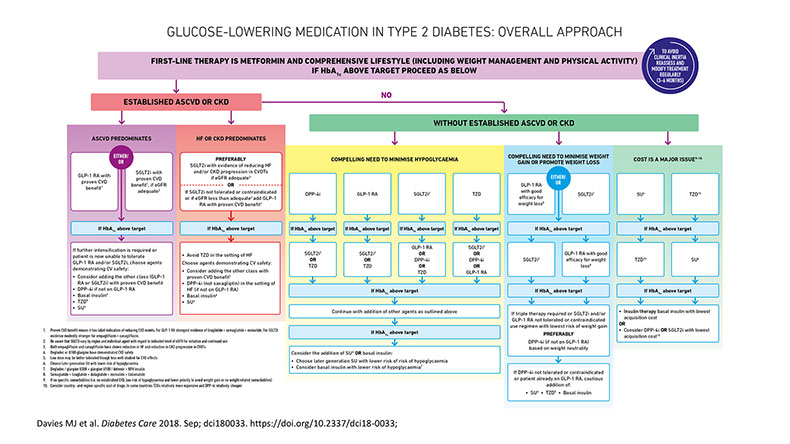If the levels are maintained then the. Duration of diabetes is a major risk factor associated with the development of diabetic retinopathy.
 What The Studies Say About Targets For Glycaemic Control Including Hypoglycaemia
What The Studies Say About Targets For Glycaemic Control Including Hypoglycaemia
Diabetic retinopathy is a leading cause of visual impairment in working-age adults worldwide.

Diabetic retinopathy guidelines 2019. Diabetic Retinopathy PPP Background. With diabetes and diabetic retinopathy a rapidly increasing problem worldwide it is vital to ensure that ophthalmologists and eye care providers are adequately prepared. If any level of diabetic retinopathy is.
8 9 The major risk factors for developing diabetic retinopathy are duration of diabetes 8 9 and severity of hyperglycemia. With increasing diabetes trends worldwide morbidity mortality and associated costs due to diabetes-related complications are a global public health concern. Retinopathy is a major cause of morbidity in patients with diabetes The vast majority of patients who develop diabetic retinopathy DR have no symptoms until the very late stages by which time it may be too late for effective treatment.
Patients with diabetes mellitus who visited various. The ICO believes an ethical approach is indispensable as it is the first step toward quality clinical practices. Five meetings of the Technical Expert Group have been held in which.
Accurate estimates of DR burden is of crucial importance for planning implementing and evaluating DR prevention and. The answer can be somewhat tricky because multiple practice guidelines for managing diabetic retinopathy DR exist both from optometry and ophthalmology. Guidelines for Diabetic Retinopathy and Eye Diseases was established by the National Task Force in 2015.
Learn more comment or download the guidelines here. Classification and severity grading of diabetic retinopathy. The guidelines draw upon the experience gained from implementing the pilot DR screening and management program in India across 10 districts spread across 10 States one district in each of the targeted States which was supported by The Trust 20132019.
The guidelines stress the importance of synergy between the two public-funded programs. Growth of new vessels leading to intraocular haemorrhage and possible retinal detachment with profound global sight loss and localised damage to the macula fovea of the eye with loss of central visual acuity. The National Program for the Prevention and Control of Cancer Diabetes.
The evidence supports the use of anti-VEGF treatment for diabetic retinopathy and laser therapy for diabetic macular oedema. Diabetic retinopathy DR is among the leading causes of vision loss at the global level. Due to the disproportionately large number of patients with type 2 diabetes this.
Referable diabetic retinopathy is defined as any retinopathy more severe than mild diabetic retinopathy with or without diabetic macular edema. New evidence was identified on the treatment of diabetic eye disease including retinopathy and macular oedema. These improvements include the widespread adoption of optical coherence tomography to assess retinal thickness and intraretinal pathology and wide-field fundus photography to reveal.
Controlling diabetes and maintaining the HbA1c level in the 6-7 range are the goals in the optimal management of diabetes and diabetic retinopathy. Standards of Medical Care in Diabetes2019. However early detection and treatment can reduce the risk of blindness by 95 percent.
A systematic review and meta. Diabetic retinopathy is a potentially blinding disease in which the threat to sight comes through two main routes. If there is no evidence of retinopathy for one or more annual eye exams and glycemia is well controlled then exams every 1-2 years may be considered.
About Diabetic Retinopathy According to the National Eye Institute vision lost to diabetic retinopathy can be irreversible. People with type 1 diabetes should have annual screenings for diabetic retinopathy beginning 5 years after the onset of their disease whereas those with type 2 diabetes should have a prompt screening at the time of diagnosis and at least yearly screenings thereafter. The prevalence of diabetic retinopathy is high.
Effects of RAS inhibitors on DR. Currently the guideline has recommendations on screening and referral but no recommendations on specific treatments. Diabetic retinopathy diagnostic assessment and treatment options have improved dramatically since the 2002 American Diabetes Association Position Statement 1.
The processes involved in guideline develop-ment were reviewed using the World Health Organizations Handbook for Guideline Development2 Guidelines for the. Wang B Wang F Zhang Y et al. The ATA seeks public comments by July 19 2019.
20 years after diagnosis 90 of patients with type 1 diabetes and 60 of those with type 2 diabetes will have some degree of retinopathy. Design Setting and Participants This prospective cross-sectional population-based study took place from August 2018 to September 2018. 10 - 14 Other important factors include.
